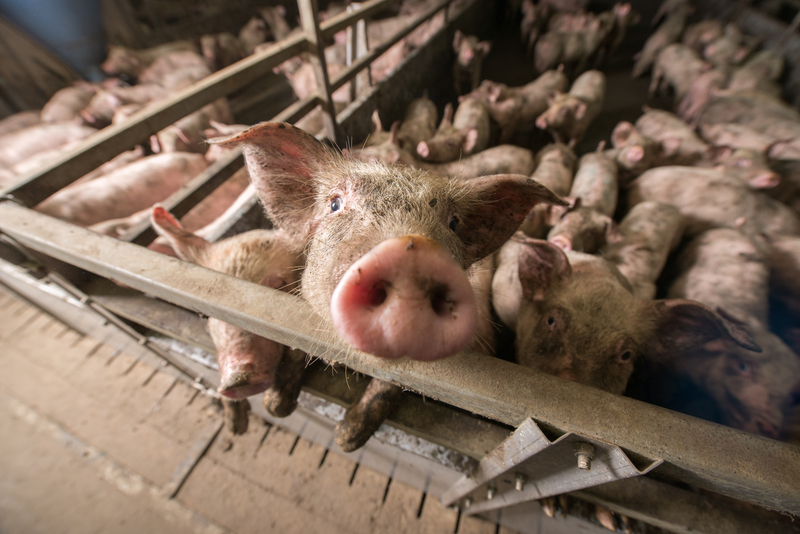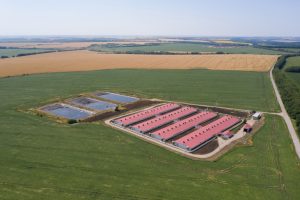
North Carolina’s hog factory farms generate as much waste as small cities, with negative impacts on residents’ health, quality of life and home values. Credit: Agnormark|Dreamstime.com.
People living in eastern North Carolina know when it’s spray day. The stench of hog manure becomes overwhelming, and collecting a brown sample requires no more than a swipe of any kitchen surface. Spray days happen several times a year when concentrated animal farm operations (CAFOs) use nutrient-rich hog manure to fertilize nearby crop fields.
Environmental economist Christopher Timmins, who moved from North Carolina’s Duke University to the Wisconsin School of Business in 2023, remembered his own drives through the region while working on a recently published study closely related to that stench.
“My colleagues and I wanted to estimate the impact of CAFO pollution on housing prices to put a dollar value on the tradeoffs people make when choosing where to live or work,” says Timmins, the Gary J. Gorman Affordable Housing Professor and an AAE affiliate faculty member. “We found that the highest pollution levels reduced prices by almost 50%.”
North Carolina is the third-largest hog producer after Iowa and Minnesota, with a much higher population density than the two Midwestern states. (Wisconsin ranks lower for pigs but is second after California for dairy cows.) This explains the study’s large sample size of 46,500 real-estate transactions. These home sales occurred between 2010 and 2014 in 43 counties with a higher proportion of non-white residents than the rest of the state. The region includes 96% of the state’s hog CAFOs, and its 10 million pigs outnumber people by a factor of 40.
North Carolina is also among the top four poultry producers. The same 43 counties contain 38% of the state’s poultry CAFOs with about 135 million chickens and turkeys. Their feces, along with carcasses, feathers and bedding, are stored and dried outside the farm in large heaps and either dispersed by the wind or used as crop fertilizer.
The air pollution behind the stench is not the only threat to human health. The second is water pollution. Hog CAFOs regularly flush the waste in their troughs into a nearby hole in the ground. This “lagoon” contains a mix of water, pig excrement and manure-digesting bacteria that turn the water pink. Nitrogen, phosphorus, ammonia and various pathogens seep from the unlined pits into the ground. Combined with the spraying of crop fields and the effect of rain on poultry feces piles, this contaminates groundwater. The problem gets worse—and spreads beyond the region—when floodwater and record-breaking rains from the likes of Hurricanes Floyd in 1999 and Florence in 2018 increase the volume of polluted water.
Since hog CAFOs need permits from the Department of Environmental Quality, the researchers used a state database to identify and map them. Their number was constant throughout the study period due to a 1998 moratorium on building new facilities. Poultry CAFOs were harder to locate as they operate under minimal regulation and do not require permits. Starting with a 2014 map from the Environmental Working Group, the team tracked the shiny roofs of these facilities on satellite images to estimate changes from 2010 to 2014. Thus, they knew whether or not a poultry farm existed at the time of each home sale.

The researchers examined homes within 10 kilometers (6.2 miles) of any CAFO in both rural and urban periphery areas. To account for differences in drinking water sources, they separately analyzed homes with private wells (21%) and those connected to piped systems with wastewater treatment. Digitized service area boundaries of public water utilities helped assign private or public water access to each home.
“Private wells are often perceived as likely exposure sources by potential buyers, causing them to reduce their offer price substantially,” notes Timmins.
To quantify pollution levels, the researchers considered CAFOs within a certain radius around each house. They multiplied the number of hogs by their average weight per growth stage to account for 10 large hogs producing a similar waste volume as 100 small hogs, for example. They used total bird counts to estimate poultry waste. The analysis model also included other determinants of housing prices, such as square footage and number of bedrooms.
The team observed the largest decrease in sales prices for homes with private wells near hog CAFOs. Compared to no exposure, the average sales price decreased by 48% for homes with private wells in the highest 5% of hog CAFO exposure and by 14% for the same exposure with access to public water. The respective decreases due to poultry CAFO exposure were 32% and 30%. The team attributed much of the decrease for homes on public water to the pervasive putrid smells.
“I have studied many other environmental influences on real-estate data and know that a price reduction of 20% is massive and 50% is almost unheard of,” says Timmins. “Exposure to the top 5% of hog CAFO pollution basically means you have an entire city’s worth of waste next to your house. For comparison, living next to a shale gas well in Pennsylvania reduces home values by about 10%.”
Until slavery was abolished, most of North Carolina’s slaveholding tobacco plantations were located in the east, and land given to freed slaves formed the basis of many townships. Since the descendants of those slaves inherited parcels of decreasing size with each new generation, the land became difficult to sell, notes Timmins.
In the 1990s, the area’s originally small pig farms began to grow, eventually becoming factory farms with thousands of animals. A state law prohibits residents from suing CAFOs for reducing their home values, leaving them with little recourse if they cannot afford to move elsewhere. North Carolina has made some efforts to reduce the scope of the problem, with little success thus far.
“In a society with high income inequality, the buyers are people who need cheap housing and are willing to make large tradeoffs,” says Timmins. “As a society, I think we need to make better decisions on where our waste should go and make polluters bear the cost of managing it.”